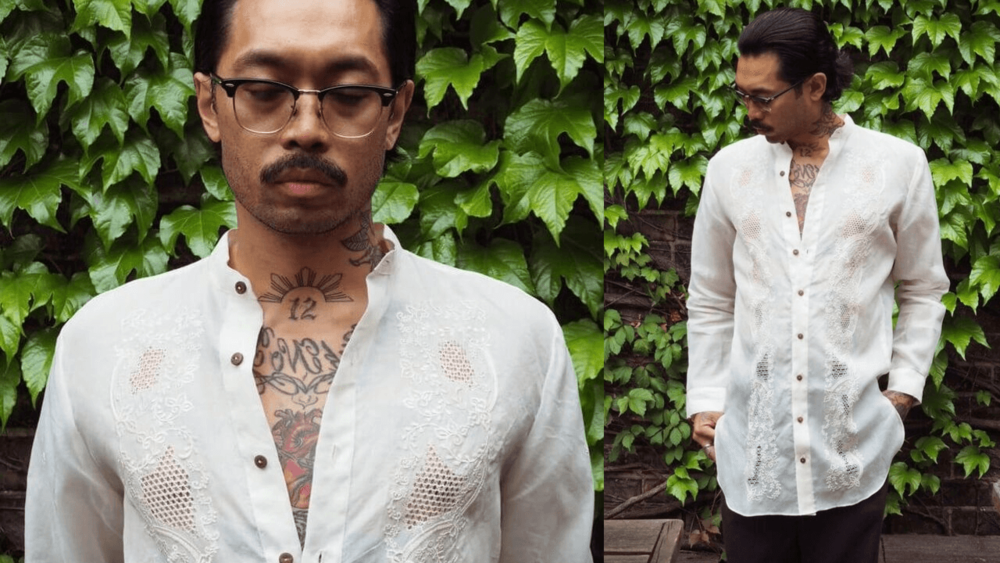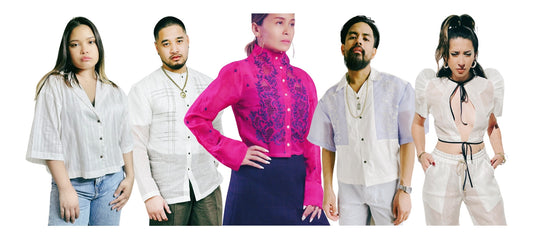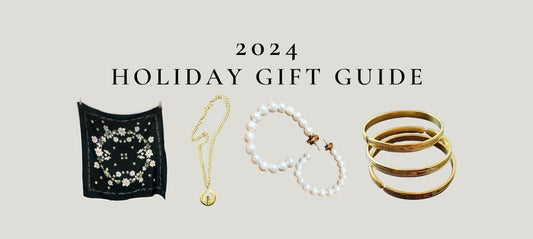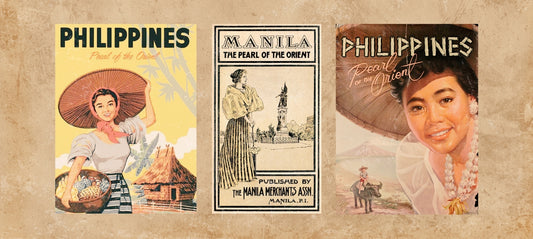The Barong Tagalog. At first glance, it’s such a simple garment. Made from delicate piña fabric (pineapple leaf) or jusi material (banana silk) and ubiquitous in the Philippines (and within Filipino diasporic communities), it seems like a very unassuming shirt often worn on special occasions — lightweight and so far from the stuffiness of a basic black tuxedo or suit normally associated with formalwear. But if you ask us, the Barong Tagalog can be one of the most stunning, elegant pieces of artwork one could ever wear, incredibly rich with history and pride. Like, it’s been through a lot.
There’s something great about the Barong Tagalog (more commonly known as simply “barong”). So unique in all its embroidered glory, the barong hints at a story behind its patterns. The craftsmanship. The hands behind the details. It’s like poetry. And then, of course, the person in the barong has to exude all that swag. That, “Je ne sais quoi,” or I guess in this case, “Hindi ko alam kung ano.” Ask any young Filipino gentleman, or gentlewoman, who has worn a custom-fit barong recently, and they would say they felt like “an Esquire model.” It’s no surprise that it’s one of the bestselling items on the VINTA shop, hands-down.
So what exactly is a barong, and why is it so important to Filipino identity today? We talked about the history of the Filipiniana Dress and the Rebirth of the Terno — now it’s the Barong Tagalog’s turn.
The History of the Barong Tagalog
The history of the Barong Tagalog is a long one — we’re talking more than four centuries ago. Wearers of the first barong span back to the pre-colonial era — the Tagalogs of Luzon wore baro, a collarless, fitted sleeve-doublet of rough cotton called “canga,” extending slightly below the waist. (Similar to the baro’t saya, traditional Filipino clothing worn by women, the root word of barong is the Tagalog word baro, meaning “outfit” or “clothing.”) Depending on their social rank, the doublet was either red, black, blue or white (red for the chiefs, black or white for the everyday folk). The people of the Visayan islands donned something similar as well — a "robe" (marlota) or jacket (baquero) made without a collar, coming down all the way to the feet and embroidered in colours.

Ilustrados and prominent Filipino writers Jose Rizal, Marcelo H. del Pilar and Mariano Ponce not wearing barongs here, but still looking fly.
By the Spanish Colonial Era from 1565, the style of the Barong Tagalog continued to evolve, with the addition of accessories that defined the wearer’s status. The Ilustrados (who were considered the Filipino educated class during the Spanish colonial period, or the “Intellectually Enlightened Class”) apparently wore the baro with a "high Elizabethan collar trimmed with lace and adorned with a gem or a big button," extending just above the knees and worn with a thin sash high across the waist.
It was believed that Spanish colonizers forced some of the Ilustrados and native Filipinos to keep their transparent barongs untucked, and without pockets, to distinguish them from the ruling class and to show that the wearer was not stealing or carrying a weapon. This was meant to humiliate the "Indios" and serve as a constant reminder that they will always be considered lower class, despite their wealth or power. Although everything still remains “in theory” (since pre-Hispanic Filipinos already wore untucked shirts, plus it was also pretty common in Southeast Asian countries, given the heat and humidity), it’s not hard to believe the super harsh discrimination during those times.

In the past, how you styled your barong determined your class. Eleuterio Dominador Lantocan, 1870.
Cut to the 19th century — hand-woven embroidery became everything. As more native Filipinos and Europeans intermingled, the baro started acquiring more of a romantic look, with embroidered patterns spread all over, not just the chest area. Some Filipinos still wore their baro loose and over their trousers, with the added flair of that kerchief-over-shoulder look or a black hat on special occasions. Then from the mid-19th century, the baro toned down a notch, with a neater, closed-neck collar, tailored into a narrow black cravat and the buttons on the cuffs removed.
After the Filipino Nationalists fought the Spanish and then the Americans, different barong styles emerged with unique designs, and the ruffled collar and cuffs made a comeback once again. The Ilustrados began wearing more elaborate embroidery designs on their barong to subtly express their rebellious disdain related to the injustices imposed on Filipinos under the Spanish regime. This type of Barong Tagalog continued to be popular until 1920, as it took on a fresh new look with its rainbow of colours and designs (think stripes and flower patterns).
There was also the two-coloured Barong Tagalog with the square embroidered design in the front, inspired by the front patterns of European dress shirts. Made of jusi and sinamay (Abaca tree fibres), the Barong Tagalog started to take on various interpretations, with wearers using it to express a more individual style. The Barong Tagalog had slowly begun to interpret itself as an independent ensemble. Mestizos (meaning people of mixed Filipino and any foreign ancestry), for example, wore the baro with imported black leather pointed shoes and bowler hat to emphasize their wealth.

19th-century Filipino men fancying up their barongs with top hats. From a watercolour album dated 1841, made by artist Justiniano Asuncion.
What was considered "the most authentic" Barong Tagalog then emerged, worn over a camisa de chino (a Chinese-inspired collarless t-shirt) and made of rengue abaca fibre. It sported a design on the half-open chest and, with a plain collar and pleated backs, it was the Barong Tagalog until 1930, popular only with the wealthier Filipinos. Ordinary Filipinos (or the “Indios”) had their collarless long-sleeved camisa de chinos, made of sinamay as a response to this fancy-looking Barong Tagalog. It was worn with slippers and loose pants, which doubled as working pants, as it could be easily folded for farm work (we can totally see many of the younger men these days copping this look). These barongs also came in bright new colours, from aquamarine to pink and pastel orange with floral embroidery.
After the inauguration of the Philippine Commonwealth on November 15, 1935 came a new variation of the Barong Tagalog conveniently named the “Commonwealth Barong Tagalog” — it featured the Philippine Commonwealth flag with the red, white and blue stripes, alongside the American flag— this is where the Filipinos’ “American Dream” began to take its hold. When the dust settled after WWII, Filipinos tried to rebuild their political independence and recreate their own identity as a nation. With this renewed faith came a host of modifications to the barong — an inner pocket was added on the left side and it was shorter in length. People also began wearing more colourful Barong Tagalog designs depicting Philippine scenes and games to instill patriotism.

President Ramon Magsaysay helped popularize the Barong Tagalog in the 50s.
Then came the election of President Ramon Magsaysay in the 1950s. President Magsaysay was the “man of the masses” — much-loved and respected by the public, as his administration was considered one of the cleanest and corruption-free in modern Philippines history. So when he started wearing the barong in all his official and personal affairs, the barong started to take on a new meaning — a symbol of honour for whoever wore it, rich or poor. President Magsaysay made the barong fashionable again, both in business and formalwear, and many succeeding presidents after took note, including President Diosdado Macapagal (from 1961-1964) and President Ferdinand E. Marcos in 1975, who actually proclaimed the Barong Tagalog as the national dress of the Philippines, announcing Barong Tagalog Week between June 5-11. To match the super extra-ness of the First Lady of the Philippines at that time, Imelda Marcos, President Marcos popularized the “all-over embroidery” type of Barong Tagalog, which eventually become synonymous with the Marcos fashion style.

Our Gardan Barong is a new interpretation of the ‘70s redesign created by Pierre Cardin for the infamous then Philippine president Ferdinand Marcos. It trickled down to street fashion and was known as the Gardan cut.
The Barong Tagalog further evolved and the semi-formal barong with short sleeves, the “Polo Barong,” started gaining popularity in recent years. Made with either cotton, ramie or chiffonile, the new Polo Barong suddenly became the unofficial work attire of the working Filipino.
The Barong Tagalog of Today a.k.a. The Modern Barong
Have you ever come across a newspaper or online article with a major headline along the lines of, “WORLD LEADERS WEAR BARONGS,” or “President Barack Obama is in a barong”? If it were any other piece of attire, it would hardly be newsworthy — but for Filipinos, it’s a thing.
There is so much pride and history seeped in the barong that when world leaders, entertainers or even non-Filipinos wear it, it has the potential to go viral. But the great thing about barongs today and its evolution is that famous celebrity/politician or not, the barong is still an accessible and versatile piece of garment, wearable as both casualwear and formalwear.
“What I love about barongs is that it’s all-season and all-wear,” explains Caroline Mangosing, VINTA Gallery founder and creative director. “Like in the Philippines, there are uniform barongs that security guards wear, office barongs that your average salary man will wear and then there are nice weekend barongs that are made of linen or cotton. Then there’s your special occasion barong for weddings and ceremonial events. Depending on the cut, the fabric and the embroidery or other embellishment, you can distinguish what type of barong it is. But it’s always recognizable as a barong.”
 As much as the barong is still a relevant and ubiquitous piece of clothing in the Philippines, in Filipino-rich North American urban communities, such as Toronto, Canada, it’s pretty difficult to find a store that actually has it. Fun fact: the GTA (Greater Toronto Area) is home to the largest Filipino community in Canada with a third of all Filipino-Canadians calling the GTA home. As of 2016, over 282,000 people of Filipino descent were living in the GTA, making them the fourth largest visible minority group in the city. Despite all of that, if you Google “where to buy a barong in Toronto,” there’s next to nothing in the city. In fact, it’s one of the reasons why VINTA Gallery was started in the first place — as executive director of the Kapisanan Philippine Centre for Arts & Culture in Toronto at the time, Caroline would receive so many calls asking whether they had or knew of places they could find barongs and ternos.
As much as the barong is still a relevant and ubiquitous piece of clothing in the Philippines, in Filipino-rich North American urban communities, such as Toronto, Canada, it’s pretty difficult to find a store that actually has it. Fun fact: the GTA (Greater Toronto Area) is home to the largest Filipino community in Canada with a third of all Filipino-Canadians calling the GTA home. As of 2016, over 282,000 people of Filipino descent were living in the GTA, making them the fourth largest visible minority group in the city. Despite all of that, if you Google “where to buy a barong in Toronto,” there’s next to nothing in the city. In fact, it’s one of the reasons why VINTA Gallery was started in the first place — as executive director of the Kapisanan Philippine Centre for Arts & Culture in Toronto at the time, Caroline would receive so many calls asking whether they had or knew of places they could find barongs and ternos.
VINTA barongs are a modern take on a beautiful tradition. So far from Barong Warehouse or Barongs R us types, VINTA Gallery promotes slow fashion, meaning each barong is hand-crafted by master couturier Estelita Lagman and our VINTA Gallery team of skilled sewers, pattern makers and embroiderers in our atelier in Manila, Philippines. Each piece is high quality, custom-made and long-lasting, which is why there are only a few VINTA barongs created and released in the store at one time.
So what goes behind the making of each VINTA Gallery barong? It starts with Caroline searching for and buying “kits” — three and a half yard cuts of silk organza or jusi, with embroidery done by an enclave of embroiderers led by Menchu Mangubat in Taal, Batangas. Embroidery designs on the barongs continue to be very Victorian-influenced to this day, with lots of vines and flowers, like the ones you see in VINTA’s Linen Gardan Barong — which is actually inspired by the 1970s redesign created by Pierre Cardin for the infamous Philippine dictator Ferdinand Marcos.
“Over the years the embroidery motifs haven’t changed all that much,” Caroline adds. “Even the process of stamping these designs have not actually changed since those days. It’s very analogue and very western. The designs are done by these old school artisans, so it’s variations of the same vines, arches, curly cue frames, flowers, etc.”



Stills from the silent film Luzon Lingerie. Caroline explains that the same design transfer technique from the 1920s is still being used today.
Caroline says she still loves the fact that the embroiderers today still use the same process of stamping the design onto the fabric through puncturing paper, mixing kerosene and zinc oxide and rubbing it through the punctured holes of the paper. (There’s a great black-and-white silent film entitled Luzon Lingerie doing this exact process.) The design gets transferred through to the fabric in a dotted white outline, then it gets stretched on a bastidor (round embroidery hoop) and embroidered on a machine, with the skilled embroiderer deftly moving the bastidor around to fill in the design. No computerized vector files here, straight analogue, skilled hands.
“Our very own embroiderer Josefina (a.k.a. Ate Jo) uses the same design transfer technique as the gentlemen in that silent film. Imagine?! It hasn’t changed since the turn of the 20th century!” Caroline mentions.
Now that VINTA has a new in-house embroiderer, Caroline’s aim is to innovate the embroidery motifs of barongs. “For the new season we are actually getting our surface designer, Chesleigh Nofiel (previously Alaga At Sining), to design all the embroidery. And he is working on designs that reference these old Victorian/colonial flora motifs, but moving from them and actually making them flora and fauna endemic to the Philippine archipelago — we are so excited for everyone to see them!”
It’s crazy to think one piece of garment can have centuries’ worth of pride, valour, discrimination, rebellion, promise and hope all rolled into one. It may be the reason why it stood the test of time and continues to be relevant… that and most likely the fact barongs just makes people look so damn good.








